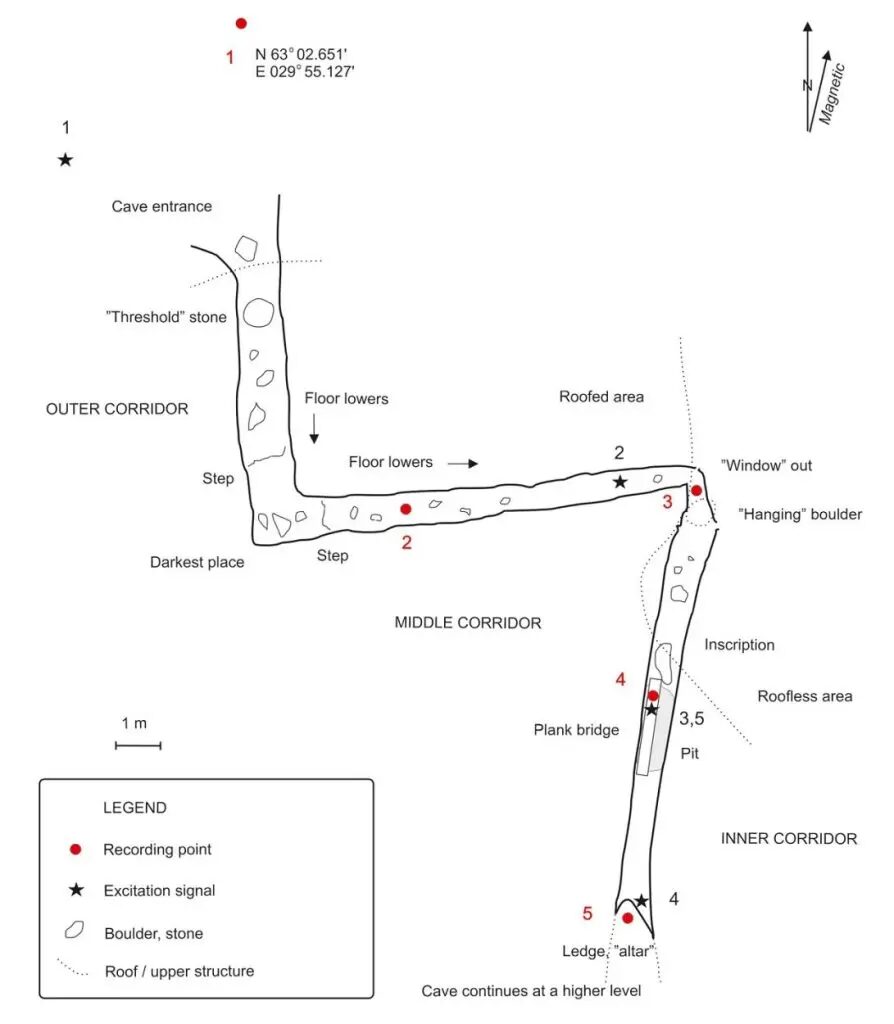
© University of Eastern Finland
The national park of Koli in eastern Finland is home to a famous, 34-metre-long crevice cave known as
Pirunkirkko, or Devil's Church in English. In folklore, this crevice cave was known as a place where
local sages would meet to contact the spirit world. Even today, the place is visited by practitioners of shamanism, who organise drumming sessions in the cave.A new article by Riitta Rainio, a researcher of archaeology at the University of Helsinki, and Elina Hytönen-Ng, a researcher of cultural studies at the University of Eastern Finland, investigates the acoustics of the Devil's Church and explores whether the acoustic properties of the cave could explain the beliefs associated with it, and why it was chosen as a place for activities and rituals involving sound.
The researchers found that the Devil's Church houses a distinct resonance phenomenon that amplifies and lengthens sound at a specific frequency. This phenomenon may have significantly impacted the beliefs and experiences associated with the cave.
Resonance as a booster of healing rituals and drumming sessionsThe researchers reviewed historical archives showing that several known sages and healers operated in the Koli area. The most famous of the sages was a man known as Kinolainen, sometimes also referred to as Tossavainen, who used the Devil's Church for magical rituals.
"According to folklore, Kinolainen would take his patients to the 'church' to talk with the Devil about the causes and cures of their ailments. This kind of a healing ritual often included loud yelling, stomping, shooting and banging," Rainio says, summarising traditional records.

© University of Eastern FinlandGround plan of the Pirunkirkko cave at Kirkkokallio, Koli.
Hytönen-Ng also interviewed and observed a modern-day practitioner of shamanism who uses the Devil's Church for rituals. According to the practitioner, there is a special energy in the cave, creating a strong connection to the surrounding nature and to one's own roots.
"The practitioner told in the interview that drumming sessions especially at the back of the cave have opened up 'new horizons'."
According to Rainio, acoustic measurements conducted in the corridor-like, smooth walled back of the cave show a strong resonance phenomenon. The phenomenon is caused by a standing wave between the smooth parallel walls, generating a tone at the natural frequency of the cave, 231 Hz, that stays audible for around one second after sharp impulses, such as clapping, drumming or loud bangs.
Tones vocalised in the cave near the 231 Hz frequency are amplified and lengthened by the cave.
"We recorded the shamanic practitioner and found that they repeatedly vocalised tones at 231 Hz, which were then amplified by the cave at its natural frequency."
A rare phenomenon in the natural environmentResonance is a common phenomenon in the built environment, especially in small rooms, but it is rare in the natural environment where smooth and solid, parallel surfaces are rarely found. According to the researchers, it can therefore be assumed that the resonance occurring in the innermost part of the Devil's Church has been an exceptional sound phenomenon for the people living in the region centuries ago.
Similar distinct resonances in the natural environment have been measured, for example, in the Palaeolithic caves of France and Spain, occurring especially near paintings on cave walls.
Rainio and Hytönen-Ng suspect that a resonance-amplified, persistent tone has probably been audible on the background of rituals performed in the Devil's Church. According to the researchers, the effect of this resonance may have been subtle and unconscious, yet it may have significantly shaped the beliefs and experiences associated with the cave.
"Where a researcher of acoustics hears as resonance, people of the past may have sensed the presence of a spirit, and a shamanic practitioner may feel the presence of an exceptional energy, each according to their background."
The study thus provides an example of how resonance can be used to establish concrete communication and dialogue with a physical space, site or the natural environment.
The study in the field of archaeoacoustics was funded by the Academy of Finland. The study was carried out in collaboration between researchers from the University of Helsinki and the University of Eastern Finland. This research continues in a project funded by the Kone Foundation (2023-2026) in which the research group examines the historical and current acoustic traditions of Fennoscandia. An audio-visual virtual reality reconstruction of the Devil's Church in Koli is currently underway for research and demonstration purposes.Research article:Rainio, Riitta & Elina Hytönen-Ng 2023. Ringing Tone and Drumming Sages in the Crevice Cave of Pirunkirkko, Koli, Finland.
Open Archaeology 2023 (9): 20220328 (Special Issue "Past Sounds: New Perspectives in the Field of Archaeoacoustics", eds. Margarita Díaz-Andreu & Neemias Santos da Rosa).
https://doi.org/10.1515/opar-2022-0328
I reckon the effect of "publish or perish" on the quality of studies is devastating ...